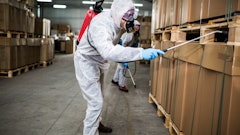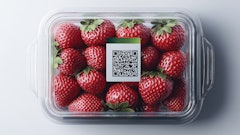As a brand new grocery store in Santa Barbara, CA, in 1915, Jordano's relied on pencil and paper to track its goods.
As it approached its 90th birthday in its current form as a $98 million marketer and supplier of food, beverages and culinary equipment in central and southern California, paper still played a large role, serving as the basis of work orders in its 100,000-square-foot warehouse.
That's a relic of the past as Jordano's distribution workers now tap the power of hand-held terminals and a wireless network to automate putaway, replenishment and item look-ups. That has helped them tighten inventory, boost productivity, increase fill rates, reduce inventories and better manage perishable goods by expiration date.
Jordano's, which sold off its retail business in the 1970s to focus on distribution, ships its 9,000 SKUs to a diverse array of customers, from restaurants and hotels to prisons, oil rigs and casinos; it even sends an annual shipment to the McMurdo and Palmer research stations in Antarctica.
Dennis Merchant , the company's director of operations, campaigned for years to upgrade Jordano's warehouse systems. At the time, merchandise was received via paper purchase orders, written onto putaway sheets and sent to the office to be manually entered hours or even a day later.
"Productivity was an issue. You'd send a guy to stock and he stocks by what he sees. The thing that hurt most was pickers go to a slot and it's not stocked," says Merchant. That could lead to incomplete orders.
In 2004, he got the go-ahead to deploy a new warehouse management system from BFC Associates Software, Chicago, to integrate with the company's AS/400-based host system. The system would automatically manage inventory, ensure smoother replenishment and help ensure Jordano's was shipping according to expiration dates.
To communicate the software's instructions to warehouse workers, Jordano's extended the wireless network backbone installed in the office out into the warehouse. Then it equipped workers with MX3X terminals from Atlanta-based LXE Inc. A chief reason for the selection was the unit's ability to stand up to Jordano's tough environment, which includes a cooler area.
"It's bulletproof," Merchant says. "The other terminals we looked at were too big and bulky. This can handle the pounding." The MX3X can also withstand temperatures to minus-4 degrees, making it suitable for refrigerated and freezer areas.
The terminals run Windows CE and the BFC Associates application and are mounted on forklifts at Jordano's.
Today, Jordano's receives goods via six Dell laptops mounted on battery-powered carts. The laptops communicate wirelessly to the host, then putaway instructions are automatically sent to the MX3X terminals via the same wireless network. Once the putaway is complete through scanning of the case and slot barcode, operators receive their next instructions.
"We track to the slot they put into in real time and track the forklift operators, so if there are some putaway issues we know who put it away," Merchant explains. Jordano's runs three warehouse shifts. The system also monitors inventory levels and orders and automatically generates replenishment instructions.
Jordano's began deployment in April 2005 in the dry goods areas of the warehouse, followed by the refrigerated and frozen areas in June. Already, Jordano's has seen the impacts of the software, network and wireless terminals.
"It's been phenomenal," says Merchant. "One thing we saw right away was tightening of the inventory, but the most change has been in cycle counting." Fill rates have also improved since slots are automatically replenished, boosting customer satisfaction. That's also enabled Jordano's to reduce the number of physical inventories it takes.
"We'll be able to manage date sensitive items. If the system tells us last week we got something that expires Dec. 1, and this week we got something that expires Nov. 30, that sends a flag to the receiver to talk to the buyer." About 40 percent of the company's SKUs are date-sensitive.
It also sends an alert when a product is received with a shorter-than-expected life span. Before, dates were checked by walking to the slot. Now that's done only to verify. "We'll be able to reduce waste."
As he did before the initial rollout, Merchant stays in contact with other users of both the host and BFC Associates software to better plan its own future uses. That includes the addition of voice-directed picking, possibly via the MX3X terminals. Jordano's also plans to acquire 40,000 square feet of additional warehouse space.
While the operations benefits are many, Merchant is most excited about the impact on customers. "We'll improve on time delivery, error rates, and fill rates. We now have all the right pieces in the right places. This will have a significant impact on our business."















